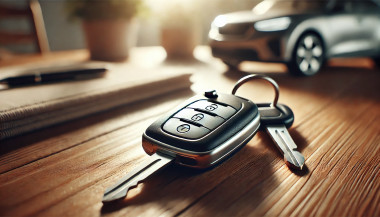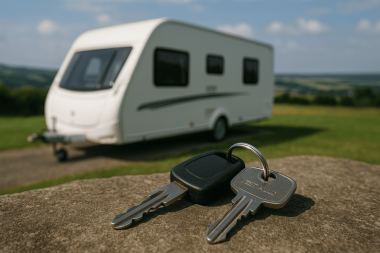Unlocking the Modern Car Key
In the past, a car key was a simple piece of metal. You inserted it into the door, turned it, and the car unlocked. You repeated the process in the ignition to start the engine. Today, however, a car key might be a sleek device that never even leaves your pocket. It may unlock your doors remotely, start the car with a button, or communicate with your vehicle without you even touching it.
This evolution in key technology has introduced convenience, security, and — for many drivers — a bit of confusion. What kind of key do you actually have? Is it a transponder key, a key fob, or a smart key? And why does it matter?
In this blog, we break down each type of modern car key, explain how they work, and highlight what makes them different — so you can better understand, maintain, and protect the device that starts your vehicle.
What Is a Transponder Key?
The transponder key was the first major step toward electronic vehicle security. Introduced in the 1990s, it features a small microchip embedded in the plastic head of a standard metal key. This chip communicates with the car's immobilizer system.
When you insert the key into the ignition and turn it, the car sends out a low-frequency signal. If the chip responds with the correct, pre-programmed code, the vehicle starts. If the code is incorrect — or missing — the car won’t start at all.
Key characteristics:
Looks like a traditional key
Contains a passive chip (no battery needed)
Requires physical insertion and turning
Designed to prevent hotwiring and unauthorized key copies
Transponder keys are still widely used, especially in vehicles produced between the late 1990s and early 2010s. They’re simple, reliable, and provide basic but effective protection against theft.
What Is a Key Fob?
The term key fob typically refers to a small, handheld remote that controls access to your car without inserting a key into a lock. Most modern fobs include buttons for locking and unlocking the doors, opening the trunk, and triggering a panic alarm. Some also support remote engine start.
In many vehicles, the fob is attached to — or integrated with — a mechanical key that includes a transponder chip. Others are "flip keys," with a metal blade that folds inside the fob casing.
Key fob features:
Enables remote locking/unlocking
May include a transponder chip
Often includes a mechanical backup key
Battery-powered (usually coin cell batteries)
May include passive entry on some models
Key fobs offer a balance between convenience and control. While you still need to press buttons or insert a key in many cases, they streamline the process and add useful features.
What Is a Smart Key?
The smart key is the most advanced and convenient type of car key available today. It communicates with your vehicle wirelessly using radio frequency or low-energy Bluetooth. As long as the smart key is within range — often in your pocket or bag — the car will unlock automatically when you touch the handle, and start when you press the ignition button.
Unlike a key fob, there’s no need to press buttons or insert anything into the ignition. The system detects the key’s presence and grants access and engine start as needed.
Smart key features include:
Passive keyless entry (PKE)
Push-button start
Proximity detection
Fully hands-free operation
Often includes comfort access features like memory seating and climate control
However, smart keys also introduce new considerations. They rely entirely on battery power, so a dead battery can temporarily disable key functions. Because smart keys are always transmitting a signal, they are also vulnerable to relay attacks, in which thieves use signal amplifiers to trick the car into unlocking.
Key Comparison Table
To help clarify the differences between each type of key, here’s a side-by-side comparison:
| Feature | Transponder Key | Key Fob | Smart Key |
|---|---|---|---|
| Physical key required | Yes | Sometimes (flip blade) | No |
| Remote locking/unlocking | No | Yes (buttons) | Yes (proximity-based) |
| Push-button start | No | No | Yes |
| Battery required | No | Yes | Yes |
| Security level | Moderate | High (with chip) | High |
| Common years of use | 1995–2012 | 2000–present | 2015–present |
| Risk of relay attack | None | Low (in some cases) | High (without signal shield) |
Why It Matters: Practical Impacts for Drivers
Understanding what kind of car key you have can save you time, money, and stress in several situations:
1. Replacing Lost or Broken Keys
Smart keys can cost anywhere from $200–$600+ to replace and usually require dealership programming. Transponder keys are cheaper and often programmable by locksmiths.
2. Diagnosing Key Issues
If your car won’t start, it could be due to a dead battery in your fob or smart key. But if you have a transponder key, the issue might be with the chip or immobilizer system.
3. Security Awareness
Smart keys are vulnerable to digital theft via relay attacks. If you have one, consider using a Faraday pouch or signal-blocking case to protect your vehicle while parked.
Want to protect your key? Browse Mr Key's security accessories here.
4. Choosing Accessories
Batteries, protective covers, signal-blocking cases, and replacement parts vary depending on your key type. Buying the wrong product can lead to frustration or compatibility issues.
Know Your Key, Protect Your Car
Your car key is more than a tool — it’s an entry system, a security feature, and a communication device. Whether you’re carrying a traditional transponder key, a button-operated key fob, or a proximity-based smart key, knowing the difference is the first step toward better security, smarter repairs, and fewer surprises.
In a world where cars are smarter than ever, your key plays a more important role than most drivers realize. Take a moment to identify which type you have — and take steps to protect it.

 (1)_1747998071.jpg)
_1733388347.jpg)
 (1)_1743685544.jpg)

